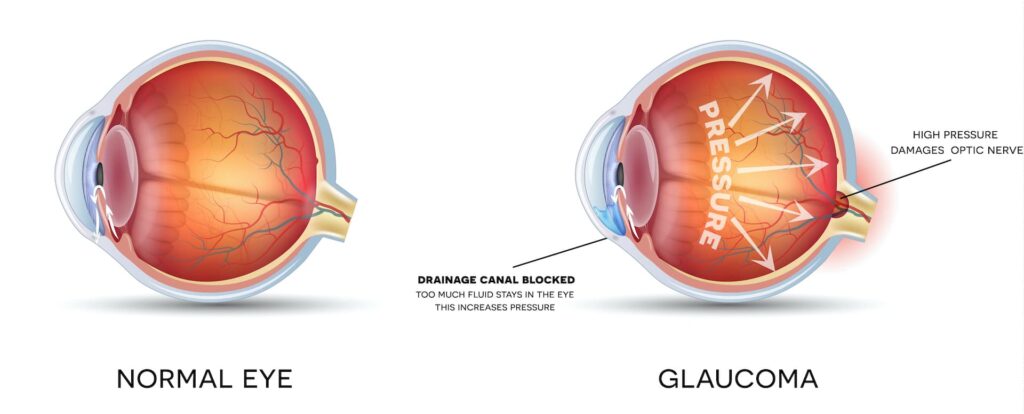What is Glaucoma?
Glaucoma is one of the leading causes of blindness in the United States and occurs when the normal pressure inside the eye rises high enough to damage the optic nerve. It has been called the “silent thief of sight” because the loss of vision often occurs gradually over a long period of time and symptoms only occur when the disease is quite advanced. Once lost, vision cannot normally be recovered, so treatment is aimed at preventing further loss.

Glaucoma Symptoms
Since symptoms do not occur until the later stages of glaucoma, routine testing by your ophthalmologist can detect glaucoma before symptoms appear. If treatments are started early enough, vision loss can be prevented. The main aim of glaucoma treatment is to lower eye pressure, either with eye drops, laser, or surgery.
The symptoms of glaucoma are gradual and can vary depending on the type and stage of progression.
For Open Angle Glaucoma many patients will begin to notice:
- Occasional blind spots in either the peripheral vision or center vision in both eyes
- With more advanced stages, tunnel vision will form
With open-angle glaucoma, most people have no symptoms. Once you experience vision loss, the condition is advanced, and the damage is already severe.
For Narrow-Angle Glaucoma, it can occur in one or both eyes, and patients can experience a sudden onset of:
- Eye pain
- Headaches
- Nausea and vomiting
- Blurred vision
- Redness
- Light Sensitivity
Symptoms with angle-closure glaucoma may be intermittent at first or may steadily worsen. You could also experience sudden, extreme pain in one eye. You could have decreased or cloudy vision, see “halos” around lights, have red eyes, or feel like you have swollen eyes. Some experience even nausea and vomiting.
If you’re experiencing any of the symptoms listed above, it is best to seek a professional immediately.
Treatment
Dr. Baynham and Dr. Hayek’s treatments for Glaucoma may include medication, most commonly prescription eye drops, or surgery such as Selective Laser Trabeculoplasty (SLT) or Minimally Invasive Glaucoma Surgery (MIGS), to help lower the pressure in the eye and prevent further damage to the optic nerve. There is minimal to no discomfort with these treatment options.
Treating glaucoma with a Selective Laser Trabeculoplasty (SLT), a special lens is placed on the front of the eye and is used to focus the laser on the area called the trabecular meshwork. After the laser treatment, you are asked to use an anti-inflammatory eye drop for 3 days. There are no restrictions post-operatively. Studies have shown that laser surgery is very good at reducing pressure in some patients. The effects can wear off over time; however, Dr. Baynham and Dr. Hayek may suggest the use of eye drops long-term.
MIGS (Minimally Invasive Glaucoma Surgery) is another type of treatment for open-angle glaucoma. It includes different types of implants, stents, or procedures used in conjunction with or without cataract surgery to help lower the pressure of the eye for patients with mild to moderate glaucoma. Dr. Joseph Hayek has been trained to use the iStent, Hydrus, and goniotomy. He will discuss these options with you and determine which MIGS procedure is the best option for your case.
While there is no cure as yet for Glaucoma, early diagnosis, and continuing treatment can preserve eyesight. Walton Eye Care is committed to your vision and has unique technology that can detect glaucoma in its early stages before damage to your eyesight takes place.
